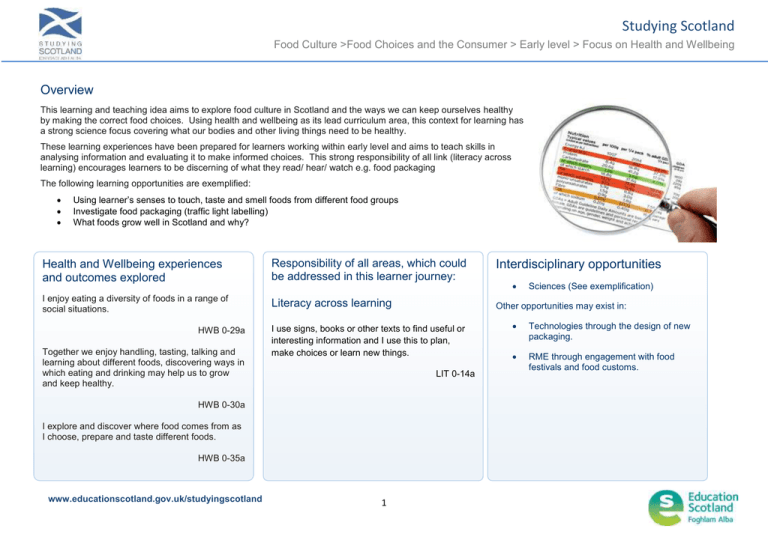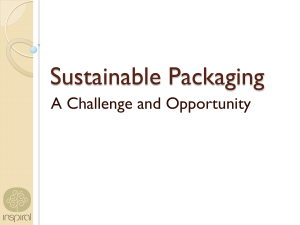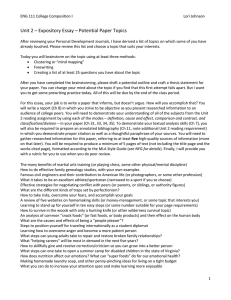Studying Scotland Overview
advertisement

Studying Scotland Food Culture >Food Choices and the Consumer > Early level > Focus on Health and Wellbeing Overview This learning and teaching idea aims to explore food culture in Scotland and the ways we can keep ourselves healthy by making the correct food choices. Using health and wellbeing as its lead curriculum area, this context for learning has a strong science focus covering what our bodies and other living things need to be healthy. These learning experiences have been prepared for learners working within early level and aims to teach skills in analysing information and evaluating it to make informed choices. This strong responsibility of all link (literacy across learning) encourages learners to be discerning of what they read/ hear/ watch e.g. food packaging The following learning opportunities are exemplified: Using learner’s senses to touch, taste and smell foods from different food groups Investigate food packaging (traffic light labelling) What foods grow well in Scotland and why? Health and Wellbeing experiences and outcomes explored Responsibility of all areas, which could be addressed in this learner journey: I enjoy eating a diversity of foods in a range of social situations. Literacy across learning HWB 0-29a Together we enjoy handling, tasting, talking and learning about different foods, discovering ways in which eating and drinking may help us to grow and keep healthy. LIT 0-14a I explore and discover where food comes from as I choose, prepare and taste different foods. HWB 0-35a www.educationscotland.gov.uk/studyingscotland 1 Sciences (See exemplification) Other opportunities may exist in: I use signs, books or other texts to find useful or interesting information and I use this to plan, make choices or learn new things. HWB 0-30a Interdisciplinary opportunities Technologies through the design of new packaging. RME through engagement with food festivals and food customs. Studying Scotland Food Culture >Food Choices and the Consumer > Early level > Focus on Health and Wellbeing This interdisciplinary approach shows some possible learning opportunities when the experiences and outcomes listed below are connected. These ideas are starting points and could be used to support planning, depending on your context. In this example we have highlighted a lead curriculum area, however, other curriculum areas can be included where relevant, based on needs and interests. HEALTH AND WELLBEING LITERACY ACROSS LEARNING (FOOD AND THE CONSUMER) *Touch, taste and smell different foods and describe them. Introduce different food groups. Grow foods outdoor areas e.g. allotments, pots, in the local community. Consider what plants and animals need to grow. Preparation and cook different foods Learn about foods that can be grown in Scotland – Consider where other foods we eat might come from e.g. Bananas are grown in hot countries, potatoes prefer moderate temperatures Take a trip to the supermarket and/ or a local shop and discuss the different foods in each shop. Make healthy food choices (at snack time, at home, in the supermarket/ local shop.) Related Experiences and Outcomes connected within this context for learning HWB 0-29a, 0-30a, 0-35a SCN 0-12, 0-03a LIT 0-14a SCIENCES www.educationscotland.gov.uk/studyingscotland Discuss the foods learners eat at home and encourage new description vocabulary. Put the foods into different food groups using the eatwell place. Look at a variety of food packaging and answer the question. *Read the traffic light food labels on foods and discuss what they mean. Consider what is a good choice of food using food labelling and packaging. E.g. red means that there is a lot of that food group etc. Exploring food using my five senses *Learning about why certain foods grow well in Scotland Introduce that some food is grown, Plant food and look after them. Establish what plants need to grow and how to look after them effectively. Being aware of diurnal and seasonal rhythms of food consumption. Use Season rhymes to learn the seasons of the year. Being aware of seasonal rhythms of food growth in Scotland 2 Studying Scotland Food Culture >Food Choices and the Consumer > Early level > Focus on Health and Wellbeing Overview of learning in lead curriculum area Possible prior experiences Learners will have gone shopping and eaten the food they have bought. Some learners may have helped plant foods e.g. potatoes Most learners will know that food is advertised on the television Some learners will know that there is information about healthy choices on food packaging Skills Possible learning opportunities in lead curricular area Remembering food groups Literacy Skills – explaining which foods they prefer/ like/ dislike Visit is local shop/ supermarket Taste different foods from a variety of food groups. Grow vegetables and herbs in the school green space/ local allotments/ pots Prepare and taste home grown foods Some learners may know that the information on food packaging is traffic light coloured Discuss food labelling and decide which colours are good colours on packaging e.g. red means high, green means low. Learners may not know about food groups and balanced diets. Consider how eating from different food groups contributes to being healthy. www.educationscotland.gov.uk/studyingscotland 3 Possible sources of evidence Do - Annotated photographs of visit to local shop/ supermarket. Analysis of information on adverts/ food packaging Write - Progress log of foods growing in garden/ allotment etc. Evaluation of information on adverts/ food packaging Say - Recorded discussion/ transcripts of discussion re food packaging and adverts Creating different recipes and food packaging. Make - Designed food packaging Studying Scotland Food Culture >Food Choices and the Consumer > Early level > Focus on Health and Wellbeing Learning experience 1: Touch, taste and smell food from different groups describe them. Possible Starting Points Resources Arrange foods from different food groups on a table and ask learners to try them. Eat well plate http://www.nhs.uk/Livewell/Goodfood/Pages/eatwell-plate.aspx Use a tick and a cross sheet with photographs of the foods – learners can tick and cross the foods they liked. Food and farming posters from (Royal Highland Education Trust (RHET) http://www.rhet.org.uk/Resources/boards Label the foods and ask the learners to guess whether these foods come from Scotland or somewhere else in the world. Ask them to explain why they have chosen the answer they did. Learning Skills Remembering the different food groups on the eat well plate There are lots of different foods available to us in Scotland. There are different food groups that we must eat to remain healthy. We should eat a variety of different foods to make sure that we have a balanced diet. Some foods need certain conditions to grow. This means that some of our food may not be from Scotland, but instead brought to Scotland from different countries. www.educationscotland.gov.uk/studyingscotland Creating a healthy plate of food from Scotland Possible evidence Recordings of learners talking about the different foods available in Scotland. An’ eat well plate’ with some Scottish produce visible, tick and cross sheets showing preferences. 4 Studying Scotland Food Culture >Food Choices and the Consumer > Early level > Focus on Health and Wellbeing Learning experience 2: Reading traffic light food labels and discussing what they mean Possible starting points Resources for Learning Using food in the establishment discuss what we need to grow to be healthy. What will help our bones and teeth become strong etc. Information for educators from BBC food labelling: http://www.bbc.co.uk/news/health-20050420 Matching games could be used to establish what is ‘healthy’ and ‘unhealthy.’ A variety of food packaging Using nursery snack time look at the food labels of certain foods and describe the traffic light part of the label. A popular advert for food (chocolate cereals, spreads etc.) to discuss whether they are shown in a healthy or unhealthy way Discuss what the labels mean and how they should be read. E.g. red means that this product has a high amount of salt or sugar and that a high amount of salt and sugar is not healthy. Skills Analysing Information Follow a recipe using ingredients Evaluating the validity of the packaging/ advert. Learning Possible evidence Some foods are healthier than others. Eating a balanced diet helps us grow and become strong. Annotated photographs of learners following ingredients Collect transcripts or recordings of learners talking about nutritional information. Transfer of good choices during break and lunch times Food packaging must display ingredients on their packaging. Some packaging uses traffic lights to display nutritional information – soon all food packaging with use this method. Pictures on food packaging can sometimes convince us to buy a product. We should be making our choices based on the nutrition information. www.educationscotland.gov.uk/studyingscotland 5 Studying Scotland Food Culture >Food Choices and the Consumer > Early level > Focus on Health and Wellbeing Learning experience 3: Why do certain foods grow well in Scotland? Possible starting points Resources for Learning Begin to grow plants, which grow well in Scotland. E.g. Potatoes, carrots, sprouts, turnips, rhubarb, strawberries, raspberries and blackcurrants. Discuss what is required for them to grow. Growing your own food http://resource.ecoschoolsscotland.org/food-environment.asp?r=3&c=343 Taste some foods from different countries e.g. bananas, tomatoes etc. These fruits need hotter temperatures. Think of places you could grow tomatoes e.g. greenhouses etc. Skills Managing each other whilst planting and growing Introduce what polytunnels are and what they are used for. Working together whilst planting and growing Begin to grow some foods in polytunnels. Discuss why polytunnels are useful for growing food in Scotland. Health and Wellbeing skills - being responsible, safe and understanding the health implications of growing your own food Learning Possible evidence Some foods grow well in Scotland because of the soil, climate and seasons. Some foods grow better in hotter countries. Some people use polytunnels to grow their food to help raise the temperature of the surroundings. www.educationscotland.gov.uk/studyingscotland 6 Do - Annotated photographs of learners planting and growing food. Make - A pictorial journal with the progress the plants are making. Say - Children discussing the planting and growing process.



